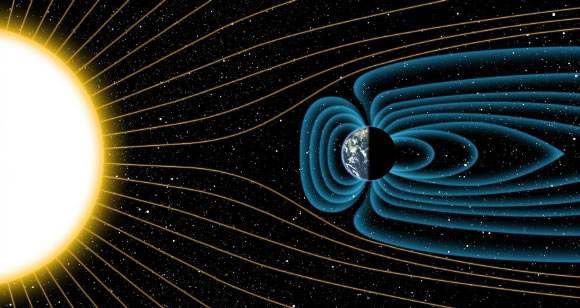American and Canadian scientists have reported in the latest issue of Science that the magnetic field of our planet is at least 4 billion years old, up from the previous estimate of 3.45 billion years.

An artist’s depiction of Earth’s magnetic field deflecting high-energy protons from the Sun around 4 billion years ago. Image credit: Michael Osadciw / University of Rochester.
Earth’s magnetic field is generated in its liquid iron core, and this so-called geodynamo requires a regular release of heat from the planet to operate.
Today, that heat release is aided by plate tectonics, which efficiently transfers heat from the Earth’s deep interior to its surface. But the time of origin of plate tectonics is hotly debated, with some researchers arguing that Earth lacked a magnetic field during its youth.
Given the importance of the magnetic field, scientists have been trying to determine when it first arose, which could, in turn, provide clues as to when plate tectonics got started and how the planet was able to remain habitable.
Fortunately for scientists, there are minerals – such as magnetite – that lock in the magnetic field record at the time the minerals cooled from their molten state.
The new results are based on the record of magnetic field strength fixed within magnetite found within zircon crystals collected from the Jack Hills of Western Australia.
The zircons were formed over more than a billion years and have come to rest in an ancient sedimentary deposit. By sampling zircons of different age, the history of the magnetic field can be determined.
The ancient zircons are tiny (0.2 mm) and measuring their magnetization is a technological challenge.
The team of geophysicists, led by Dr John Tarduno from the University of Rochester, used a unique superconducting quantum interference device, or SQUID magnetometer, that provides a sensitivity ten times greater than comparable instruments.
But in order for today’s magnetic intensity readings of the magnetite to reveal the actual conditions of that era, the scientists needed to make sure the magnetite within the zircon remained pristine from the time of formation.
Of particular concern was a period some 2.6 billion years ago during which temperatures in the rocks of the Jack Hills reached 887 degrees Fahrenheit (475 degrees Celsius).
Under those conditions, it was possible that the magnetic information recorded in the zircons would have been erased and replaced by a new, younger recording of Earth’s magnetic field.
“We know the zircons have not been moved relative to each other from the time they were deposited. As a result, if the magnetic information in the zircons had been erased and re-recorded, the magnetic directions would have all been identical,” Dr Tarduno said.
Instead, the team found that the minerals revealed varying magnetic directions, convincing him that the intensity measurements recorded in the samples were indeed as old as 4 billion years.
The intensity measurements reveal a great deal about the presence of a geodynamo at the Earth’s core.
“Solar winds could interact with the Earth’s atmosphere to create a small magnetic field, even in the absence of a core dynamo,” Dr Tarduno said.
“Under those circumstances, we calculate that the maximum strength of a magnetic field would be 0.6 micro-Teslas. The values measured were much greater than 0.6 micro-Teslas, indicating the presence of a geodynamo at the core of the planet, as well as suggesting the existence of the plate tectonics needed to release the built-up heat.”
“There has been no consensus among scientists on when plate tectonics began. Our measurements, however, support some previous geochemical measurements on ancient zircons that suggest an age of 4.4 billion years,” Dr Tarduno said.
“The magnetic field was of special importance in that eon because solar winds were about 100 times stronger than today. In the absence of a magnetic field, the protons that make up the solar winds would have ionized and stripped light elements from the atmosphere, which, among other things, resulted in the loss of water.”
Scientists believe that Mars had an active geodynamo when that planet was formed, but that it died off after 4 billion years.
“As a result, the Red Planet had no magnetic field to protect the atmosphere, which may explain why its atmosphere is so thin. It may also be a major reason why Mars was unable to sustain life,” Dr Tarduno said.
_____
John A. Tarduno et al. 2015. A Hadean to Paleoarchean geodynamo recorded by single zircon crystals. Science, vol. 349, no. 6247, pp. 521-524; doi: 10.1126/science.aaa9114







